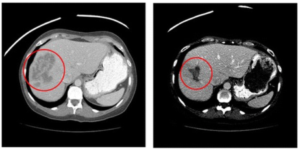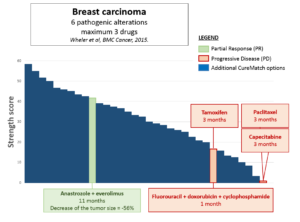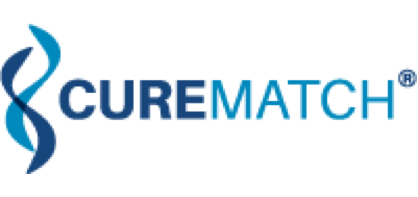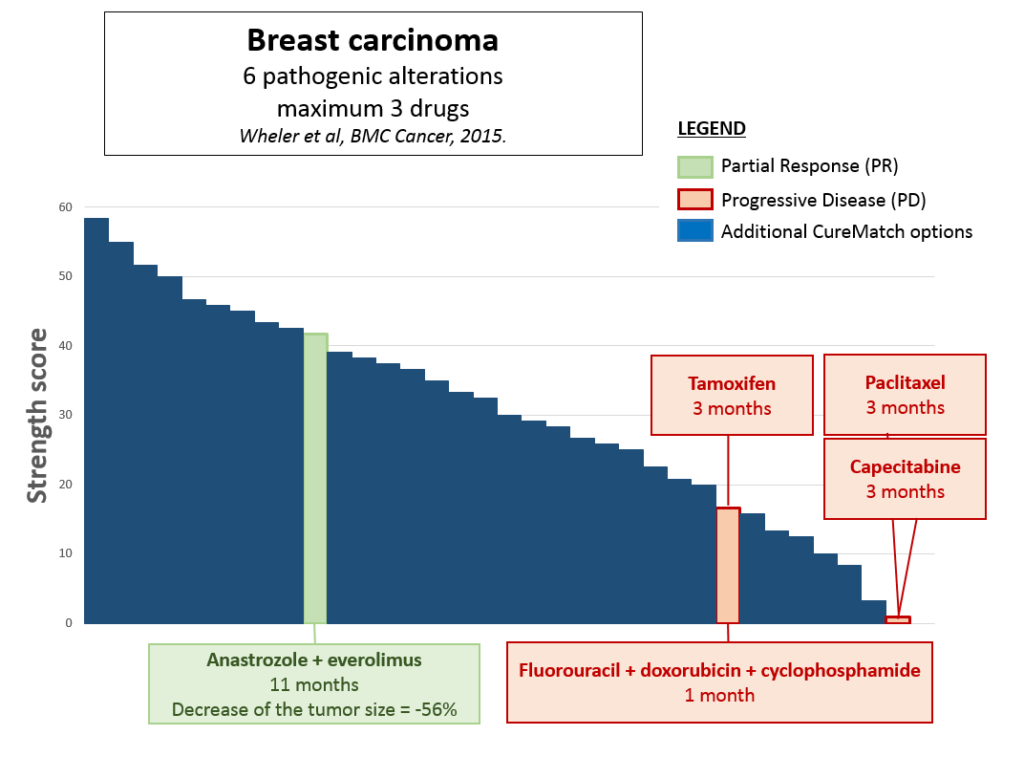CureMatch Correctly Ranks Therapy that Led to Extraordinary Response in Metastatic Breast Cancer Patient
In this case study, a retrospective analysis was performed using data from a metastatic breast cancer patient. The patient was given five lines of treatment; the first four quickly failed and the fifth was highly successful. The analysis shows that CureMatch can correctly rank the efficacy of treatment options, and illustrates multiple benefits of using the CureMatch analysis.
Case Study
A 38-year old woman was diagnosed with breast cancer in August 2009. The histologic diagnosis was invasive ductal adenocarcinoma, expressing estrogen receptor (ER) and progesterone receptor (PR). The initial tumor had already spread and metastatic liver disease was observed on CT scans.
Soon after diagnosis, the patient received her first line of chemotherapy, consisting of paclitaxel. The treatment was stopped after 3 months, due to lack of efficacy. Additional lines of treatment included chemotherapy (fluorouracil/doxorubicin/cyclophosphamide), a single-agent hormone therapy (tamoxifen), and additional chemotherapy (capecitabine). None of these therapies helped to reduce the size of the tumor, and progression of the disease was observed in less than 3 months with each of them.
After the fourth relapse, that patient’s physician decided to perform DNA-sequencing on the primary breast tumor sample, to seek personalized therapy options. Next-generation DNA sequencing was performed by Foundation Medicine (FoundationOne® – 315 gene panel). The analysis revealed pathogenic alterations within CCND1, FGFR1 and PRKDC genes. Additional protein analysis revealed a loss of the PTEN protein. Following these molecular profile insights, her physician prescribed personalized combination therapy: anastrozole (hormone therapy) in combination with everolimus (targeting the CCND1 and PTEN alterations).
Rapidly following the combination therapy, the size of the liver metastases decreased by 56%, and the patient was considered to be in partial response, which has continued for at least 11 months after treatment initiation.

Fig. 1. CT scans of the abdomen before treatment (left) and after 6 months of treatment (right). After 6 months the patient exhibited a partial response (56% decrease in hepatic disease).
Retrospective Analysis
The CureMatch analysis was retrospectively performed to determine whether CureMatch would have been effective in correctly ranking therapy options, using published patient data. A score distribution from the resulting CureMatch report is shown in Fig. 2, which ranks the likely efficacy of various treatment options using combinations of 1, 2, or 3 drugs. The efficacy of the options is ranked by descending Strength Score, which is a proprietary scoring system developed by CureMatch that analyzes the individual patient’s molecular tumor profile and estimates the best therapeutic agents using proprietary algorithms and manually-curated databases.

FIg. 2. Score Distribution from CureMatch report. All possible combinations of 1, 2, or 3 drugs are represented and ordered by descending strength score. The successful therapy is shown in green, the unsuccessful lines of treatment in red, and other potential options (that could have also been considered) in blue.
In the CureMatch report, the successful personalized combination therapy option (anastrozole + everolimus) received a Strength Score of 42, whereas all of the unsuccessful chemotherapy and hormone therapy options (shown in red) had scores below 20. Other potential therapy options that were suggested by CureMatch as options, but not considered for the patient during treatment, are also shown in the plot in blue.
The conclusions are two-fold:
- If the patient had received DNA sequencing and the CureMatch analysis immediately following the initial diagnosis, four unnecessary lines of treatment (chemotherapy and hormone therapy) may have been avoided, likely reducing the following:
- Exposure to unnecessary chemicals and their toxicities
- Wasted time, during which there was further spread of the disease
- Cost of unnecessary treatments
- Drug resistance resulting from unnecessary/unsuitable treatments, which may affect the efficacy of subsequent treatments
- Negative impacts to the emotional health and quality of life of the patient
- An even more effective therapy could have been chosen. Note that in Fig. 2, the selected therapy had a Strength Score of 42. However, if the CureMatch analysis had been available, at least nine even higher-ranked options could have also been considered (shown in blue to the left of the selected option), including four options with scores above 50.
This case study further supports the notion that personalized combination therapy should be considered early in the treatment process. CureMatch empowers oncologists with the knowledge and insight to consider these options for their patients.
The original study was published by UCSD oncologist and CureMatch co-founder Dr. Razelle Kurzrock and her colleagues in the journal BMC Cancer. Co-authors on the article were J.J. Wheler, J.T. Atkins, F. Janku, S.L. Moulder, R. Yelensky, P.J. Stephens, and Razelle Kurzrock. The subsequent retrospective analysis was performed by CureMatch.

